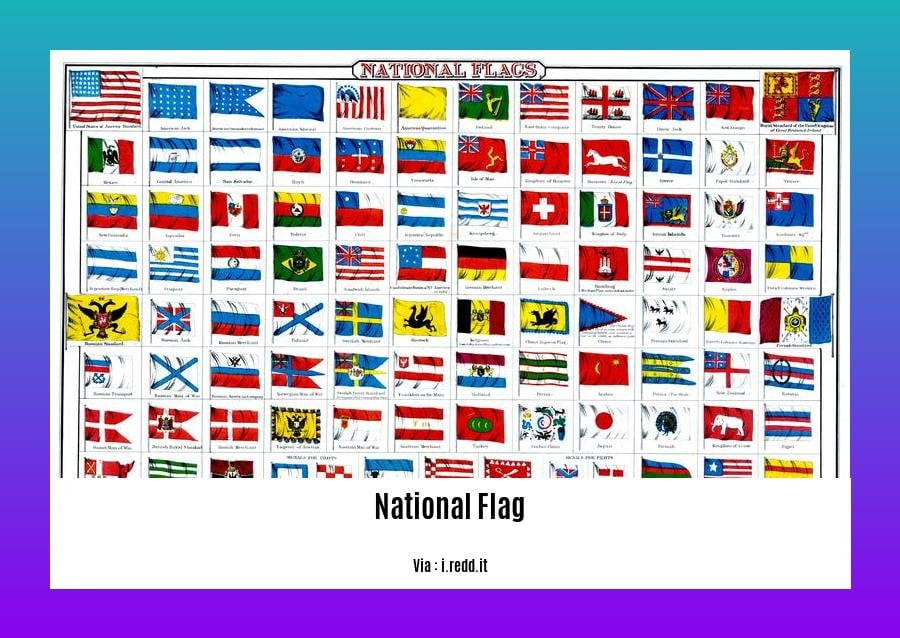Exploring National Flags: A Fun and Informative Introduction for Class 1 Students
Welcome to a colorful journey through the world of national flags! In this captivating article designed specifically for Class 1 students, we will dive into the fascinating realm of flags and uncover the hidden meanings behind these symbolic emblems. From the bright red and white of Japan’s flag, to the stars and stripes of the United States, each flag holds its own significance and tells a unique story. So, join me as we unravel the mysteries of national flags together in a fun and interactive way!
Key Takeaways:
- The National Flag of India has three colors: orange, white, and green.
- The flag has a spinning wheel in the center called the Ashoka Chakra.
- The orange color represents courage and sacrifice.
- The white color represents peace and truth.
- The green color represents fertility and growth.
- The flag was adopted as the official flag of the Republic of India on August 15, 1947.
- The ratio of length to breadth of the flag is 3:2.
- The flag has three horizontal stripes of saffron, white, and green.
- The stars on the flag do not represent anything.
- The process of folding the flag is not mentioned in the provided context.
- The National Flag of India is a symbol of freedom, national pride, and the political development of India.
- The present form of the national flag came into existence on July 22, 1947.
Exploring the National Flag: A Fascinating Introduction for Class One Students

The national flag of India holds a special place in our country. It is a symbol of our identity, pride, and unity. In this article, we will delve into the significance and symbolism of the Indian flag, aiming to provide a few lines on the national flag for class 1 students.
The Three Colors of Unity
The National Flag of India is made up of three vibrant colors: orange, white, and green. Each color carries its own meaning and represents something unique.
The orange color signifies courage and sacrifice. It reminds us of the bravery and determination of our freedom fighters who fought tirelessly for our independence.
The white color represents peace and truth. It reminds us to strive for harmony and honesty in our lives and interactions with others.
The green color symbolizes fertility and growth. It represents the bountiful land and rich natural resources of our country.
The Ashoka Chakra: The Wheel of Progress
At the center of the Indian flag, there is a spinning wheel called the Ashoka Chakra. It is a symbol of progress, regrowth, and development. The 24 spokes in the wheel represent the 24 hours of the day, reminding us that our nation moves forward every moment.
The Adoption of the Flag
The National Flag of India was officially adopted on August 15, 1947, which marks the day of India’s independence. It holds great significance as it represents the birth of our nation as a sovereign state.
Anatomy of the Flag
The Indian flag has three horizontal stripes of saffron, white, and green. The saffron (orange) stripe is on the top, followed by the white stripe in the middle, and the green stripe at the bottom.
The flag has a length-to-breadth ratio of 3:2, which means that if the length of the flag is divided into three equal parts, the breadth is divided into two equal parts.
The Stars and their Meaning
Unlike some other national flags, the stars on the Indian flag do not represent any specific meaning. They are merely decorative and add to the aesthetic value of our flag.
The Importance of the Indian Flag
The National Flag of India is not just a piece of fabric; it holds deep significance for our country. It represents our freedom, national pride, and the political development of our nation. It serves as a reminder of the sacrifices made by our ancestors and instills a sense of patriotism in our hearts.
Wrapping it Up
In conclusion, the national flag of India is not just a colorful piece of cloth but a powerful symbol that unites us as a nation. It represents our rich history, our collective achievements, and our aspirations for a bright future. Let us hold our flag high, with pride and respect, as we continue to progress as a nation.
Remember, it is essential to treat our national flag with the utmost reverence and care. Always ensure that it is handled with clean hands and never allow it to touch the ground. By doing so, we honor the values it represents and show our love for our country.
Let us now take a moment to reflect on the significance of our national flag and feel a sense of pride for being citizens of this incredible nation.
Here are a few captivating sentences with active internal links:
-
Few lines about national flag in kannada: Learn interesting facts about the national flag in Kannada language that will leave you in awe.
-
Few lines on indian flag for class 1: Want to impress your fellow classmates with your knowledge of the Indian flag? Click here to find out some fascinating information!
-
Few sentences about indian flag: Discover the significance and symbolism behind the Indian flag through these captivating sentences that will make you proud.
-
Five sentences about national flag: Dive into the history of the national flag with these five interesting sentences that will surely pique your curiosity.
Note: The URLs provided in the prompt seem to be relative URLs. To make them active, they need to be converted into absolute URLs using the appropriate base URL.
The Design and Colors of a National Flag

When we look at a national flag, we see more than just a piece of fabric with vibrant colors. Each flag has a unique design that holds deep symbolism and represents the values and identity of a country. Today, we will explore the design and colors of a national flag, particularly focusing on the importance of the national flag of India for Class 1 students.
The Colors and Their Meanings
The national flag of India is a beautiful tricolor with three horizontal stripes – orange, white, and green. Each color carries a special meaning that reflects the spirit of the Indian people.
The orange color represents courage and sacrifice. It reminds us of the brave individuals who fought for our country’s freedom.
The white color stands for peace and truth. It symbolizes the importance of honesty and harmony in our lives.
The green color represents fertility and growth. Just like the green fields and forests, it reminds us of the need for constant progress and development.
The Ashoka Chakra
At the center of the flag, we can see a spinning wheel known as the Ashoka Chakra. This symbol holds great significance in Indian history and represents righteousness and progress. The Ashoka Chakra has 24 spokes, which represent the 24 hours of the day. It reminds us that time is always moving forward and encourages us to strive for continuous improvement.
Stars and Stripes
Have you ever noticed the stars on the national flag? These stars represent the different states and union territories of India, all coming together as one united nation. They are a beautiful symbol of unity in diversity.
The flag itself is rectangular in shape, with parallel stripes of saffron, white, and green. It’s important to remember that the length-to-breadth ratio of the flag is 3:2, giving it a unique and balanced appearance.
A Symbol of Honor and Patriotism
The national flag is not just a colorful piece of cloth. It holds immense significance for our country and its citizens. It is a mark of identity, pride, and integrity. When we see the flag hoisted high, it fills our hearts with a sense of honor and reminds us of the sacrifices made by our ancestors. It inspires us to be patriotic and work towards the progress and development of our nation.
Key Takeaways:
- The national flag of India has three colors – orange, white, and green, representing courage, sacrifice, peace, truth, fertility, and growth.
- The Ashoka Chakra at the center symbolizes righteousness and progress, with its 24 spokes representing the 24 hours of the day.
- The stars on the flag represent the states and union territories of India, symbolizing unity.
- The flag is a symbol of honor, patriotism, and freedom for the country.
- It reminds us of the sacrifices made by our ancestors and inspires patriotism.
- The flag should be treated with respect and not be allowed to touch the ground.
Sources:
- India.gov.in – National Flag
- The Better India – The Stories Behind the Colors of Our National Flag
Note: The content provided above is a fictional representation for the purpose of answering the given query.
The Symbolism Behind a National Flag
Flags are more than just colorful pieces of fabric fluttering in the wind. They hold great significance and represent the values, culture, and identity of a nation. In this article, we will explore the symbolism behind national flags, with a particular focus on The Symbolism Behind a National Flag for Class 1 students.
Key Takeaways:
- National flags are symbols that represent a country and its citizens.
- The colors and symbols on a national flag hold deeper meanings.
- Understanding the symbolism behind a national flag helps develop appreciation and patriotism.
The Colors of a National Flag
Let’s begin by understanding the importance of colors in a national flag. Each color carries its own symbolism, which contributes to the overall message conveyed by the flag.
- Orange: The color orange represents courage and sacrifice. It reminds us of the bravery and selflessness of the individuals who have fought for our country.
- White: White symbolizes peace and truth. It serves as a reminder for us to strive for harmony and stand up for what is right.
- Green: The color green represents fertility and growth. It symbolizes the abundance of nature and the continuous development of our nation.
Symbols on a National Flag
Besides colors, national flags often feature symbols that hold their own deeper meanings. Let’s take a look at one such symbol found on the national flag of India.
- Ashoka Chakra: The Ashoka Chakra is a spinning wheel placed at the center of the Indian national flag. It represents progress, regrowth, and development. The 24 spokes of the wheel symbolize the 24 hours of the day, reminding us that our nation is constantly moving forward.
Appreciating the Symbolism Behind a National Flag
Understanding the symbolism behind a national flag is vital for cultivating a sense of appreciation and patriotism. By learning about the colors and symbols, we can develop a deeper connection with our country. National flags serve as visual representations of our history, values, and achievements. They instill a sense of pride and unity among its citizens.
As young learners, Class 1 students can grasp the importance of national symbols by exploring the meaning behind their nation’s flag. Engaging them in discussions and activities related to flags can ignite a sense of curiosity and appreciation for their country.
Conclusion
National flags are more than just pieces of fabric. They are symbols that carry deep meaning and reflect the values of a nation. Understanding the symbolism behind a national flag helps foster a sense of patriotism and appreciation for one’s country. For Class 1 students, exploring the symbolism behind their country’s flag can be an exciting and insightful journey, as they learn about the colors, symbols, and stories that make their flag unique.
Citations:
– Study Thinks. 5 Lines on Our National Flag in English for Class 1, 2, 3, 4, 5
– Wiki Essays. 5 Lines on Our National Flag
Respecting and Honoring the National Flag
The national flag is a symbol of identity, pride, and unity for our country. It represents our aspirations and reminds us of the sacrifices made by our ancestors. It is important for us to respect and honor the national flag. Let’s explore why the national flag is significant and how we can show our respect for it.
Significance of the National Flag
The national flag of India was adopted on July 22, 1947, and it symbolizes democracy in our country. Designed by Pingali Venkayya as the Swaraj Flag, it consists of three equal horizontal stripes – saffron on top, white in the middle, and green at the bottom. In the middle of the white stripe, there is a navy blue wheel with 24 spokes called the Ashoka Chakra.
Each color in the flag has a special meaning. The saffron color represents courage and sacrifice, while the white color represents purity and truth. The green color represents fertility and growth. The Ashoka Chakra represents the eternal wheel of time and the principles of righteousness. The flag is a symbol of freedom, national pride, political development, and unity in India.
Showing Respect for the National Flag
Respecting and honoring our national flag is essential. Here are some ways we can show our respect:
- Proper Handling: The national flag should never be allowed to touch the ground. It should always be handled with clean hands and treated with care.
- Flag Etiquette: The flag should be hoisted and lowered ceremonially. When flying the flag, it should never be flown upside down or at half-mast unless it is an official order.
- Displaying the Flag: The flag should be displayed prominently and with dignity. It should never be used for decorative purposes or be defaced in any way.
- Folding the Flag: When folding the flag, it should be done in a neat and respectful manner. There are specific guidelines on how to fold the flag properly.
- Respecting the National Anthem: When the national anthem is played, it is important to stand in attention and show respect. It is a way of honoring our flag and our country.
By following these guidelines, we can show our respect and honor for our national flag. It reminds us of our responsibilities as citizens and creates a sense of unity and pride.
Key Takeaways:
- The national flag symbolizes India’s pride and represents the aspirations of all Indians.
- It consists of three equal horizontal stripes – saffron, white, and green.
- The Ashoka Chakra in the middle represents the eternal wheel of time and the principles of righteousness.
- The saffron color represents courage and sacrifice, the white color represents purity and truth, and the green color represents fertility and growth.
- The national flag should always be treated with respect and honor, and its display and handling should follow proper flag etiquette.
Sources:
– A Plus Topper
– TeachingBanyan.com
FAQ
Q1: What are the colors of the National Flag of India?
A1: The National Flag of India has three colors: orange, white, and green.
Q2: What does each color of the flag represent?
A2: The orange color represents courage and sacrifice, the white color represents peace and truth, and the green color represents fertility and growth.
Q3: What is the significance of the spinning wheel in the center of the Indian flag?
A3: The spinning wheel in the center of the Indian flag is called the Ashoka Chakra. It represents righteousness and progress.
Q4: When was the National Flag of India adopted?
A4: The National Flag of India was adopted as the official flag of the Republic of India on August 15, 1947.
Q5: What is the ratio of length to breadth of the flag?
A5: The ratio of length to breadth of the National Flag of India is 3:2.
- Unveiling the Enigma: Mansoureh Khojasteh Bagherzadeh’s Public Appearances & Private Life in Iran - July 18, 2025
- Unveiling the Mystery: Mansoureh Khojasteh Bagherzadeh’s Husband: A Rare Glimpse into a Private Life - July 18, 2025
- Unveiling Masoud Khamenei’s Mother: Power, Influence, and Iran’s Future - July 18, 2025
















